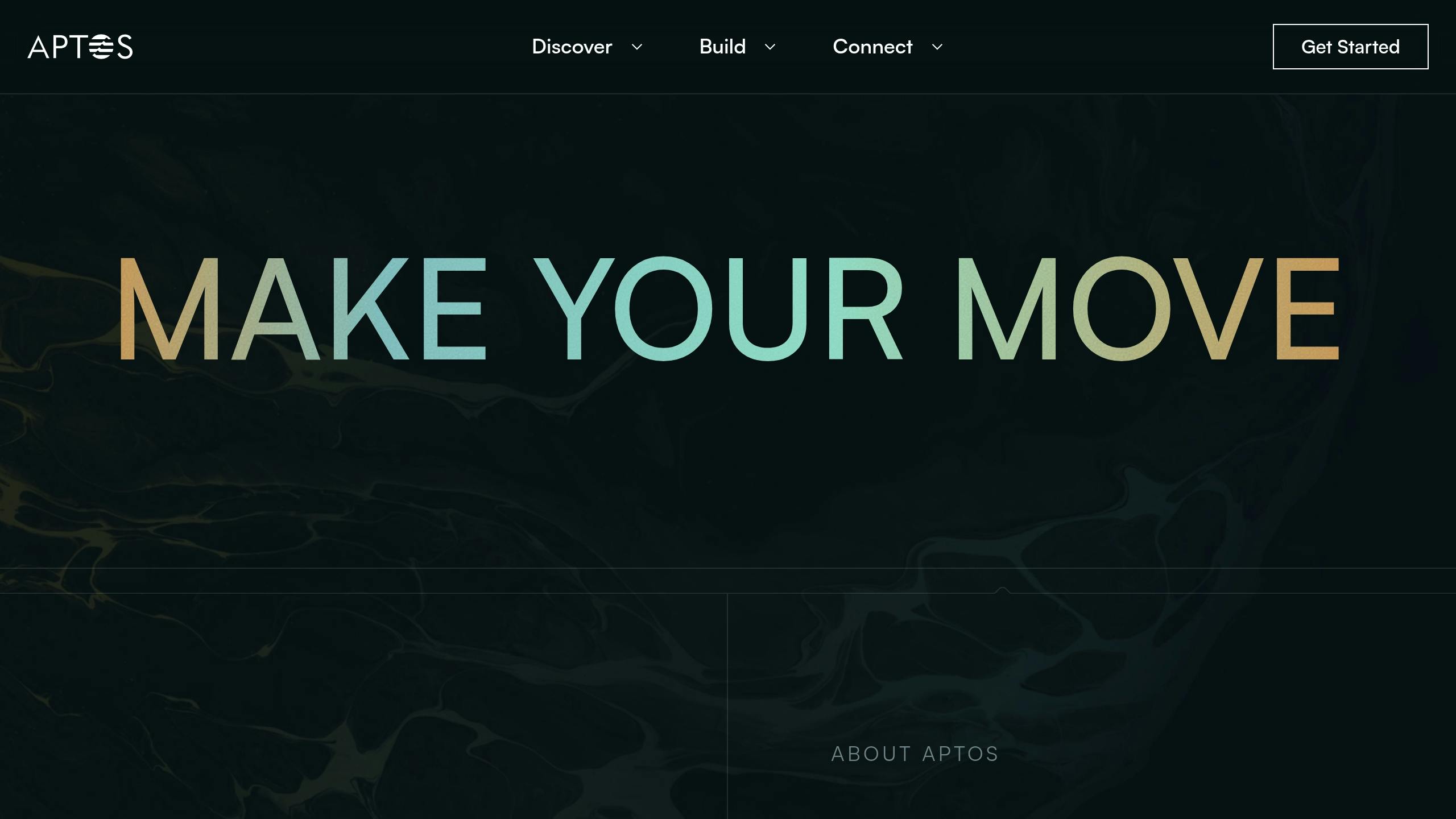Aptos is a high-performance Layer 1 blockchain developed by former Meta engineers, leveraging the Move programming language for secure and efficient smart contracts. It processes up to 160,000 transactions per second (TPS) using Block-STM technology for parallel execution and the AptosBFT consensus mechanism for reliability. With sub-second transaction finality and low fees ($0.0005), Aptos supports a thriving ecosystem of DeFi, NFTs, and business applications.
Why Aptos Stands Out:

- For Developers: Move language ensures secure and efficient dApps.
- For Users: Near-instant transactions and minimal fees.
- For Enterprises: Scalable infrastructure for large-scale operations.
Key Ecosystem Highlights:
- DeFi Platforms: Liquidswap, PancakeSwap, Aries Markets, and Ditto Finance lead with advanced trading and low fees.
- NFT Markets: Topaz processes over 1M transactions monthly with sub-second speeds.
- Wallets: Petra Wallet (500K users) and others like Martian, Pontem, and Fewcha offer secure and user-friendly options.
- Use Cases: From DeFi (Thala Labs, AptosSwap) to gaming (Aptos Knights, CryptoRacers) and enterprise solutions (LVMH supply chain, JP Morgan asset tokenization).
Quick Comparison of Features:
| Feature | Key Details |
|---|---|
| Programming | Move language with resource-oriented design |
| Consensus | AptosBFT with Proof-of-Stake mechanism |
| Performance | 160,000 TPS, sub-second finality |
| DeFi Highlights | Liquidswap ($80M TVL), PancakeSwap integration |
| NFT Growth | Topaz with 1M+ transactions/month |
| Wallets | Petra, Martian, Pontem, Fewcha, Rise |
Aptos combines speed, security, and scalability, making it a top choice for developers, users, and enterprises alike.
What is Aptos & How Its Tech Actually Works
Aptos Technical Structure
The Aptos blockchain is built on three core components that prioritize high performance and security. Let’s break down these components and how they contribute to the ecosystem.
Move Language Basics
Move brings a fresh approach to smart contract programming with its resource-oriented design. This structure treats digital assets as core elements, ensuring stronger safeguards for decentralized applications.
Key features of Move include:
- A static type system that catches errors during the compilation phase.
- A resource-oriented model that prevents issues like asset duplication or accidental deletion.
- The Move Prover, which allows developers to mathematically verify contract logic.
The Move Prover enhances security by addressing common issues like reentrancy attacks and asset mismanagement, making it a strong tool for building reliable smart contracts.
Block-STM Performance
Block-STM (Software Transactional Memory) technology is a standout feature of Aptos, enabling parallel transaction processing. This method boosts blockchain performance while maintaining security. It achieves:
- Sub-second finality times[3].
- The ability to process transactions simultaneously without needing a predefined execution order.
Block-STM’s efficiency comes from:
- Parallel execution of transactions without requiring prior knowledge of read/write sets.
- Automatic conflict resolution for overlapping operations.
- Optimized use of hardware resources, ensuring smooth performance.
This technology supports the high transaction speeds and reliability demanded by decentralized finance (DeFi) applications.
Proof-of-Stake System
AptosBFT integrates a proof-of-stake mechanism with Byzantine Fault Tolerance (BFT) to deliver quick finality[1]. The system functions through:
- Validator selection based on the amount of APT tokens staked.
- Stronger security achieved by incorporating the BFT protocol[1].
This consensus model ensures the network is both efficient and secure, making it suitable for enterprise-level applications.
Together, the Move language, Block-STM, and AptosBFT create a robust blockchain infrastructure. This setup supports advanced decentralized applications while maintaining top-tier security and transaction speeds.
Aptos Ecosystem Parts
Aptos’ technical design supports practical applications through its parallel execution system and Move-based security features.
DEX Platforms
Aptos’ ability to handle 160,000 transactions per second (TPS) [3] has powered advanced trading platforms. Liquidswap leads with concentrated liquidity pools [3][5], holding $80 million in total value locked (TVL) and a 35% market share. PancakeSwap‘s integration into Aptos added significant activity, processing $50 million in daily trading volume [8]. Aries Markets offers leveraged trading up to 10x [4], while Ditto Finance attracts users with its low 0.1% trading fees [9].
| DEX Platform | Market Share | Key Features |
|---|---|---|
| Liquidswap | 35% | Concentrated liquidity pools |
| PancakeSwap | 30% | Cross-chain support, Yield farming |
| Aries Markets | 20% | Leveraged trading |
| Ditto Finance | 10% | Low-fee structure |
NFT Markets
Aptos’ NFT ecosystem is growing quickly, complementing its DeFi platforms. Topaz has capitalized on AptosBFT’s sub-second transaction finality [1], processing over 1 million NFT transactions in January 2025 [10]. Its standout features include:
- Near-instant transaction speeds
- Custom royalty systems with cross-chain bridging support
Wallet Options
Aptos wallets incorporate Move’s asset protection mechanisms, offering a range of specialized features. Petra Wallet, the official Aptos wallet, leads the pack with over 500,000 active users.
| Wallet | User Base | Notable Features |
|---|---|---|
| Petra | Mainstream users | Official integration, DApp browser |
| Martian | Advanced traders | Cross-chain compatibility [7] |
| Pontem | DeFi users | Yield optimization tools [2] |
| Fewcha | Security-focused | Hardware wallet integration [6] |
| Rise | New users | Social recovery features |
These wallets serve as essential gateways to Aptos’ DeFi and NFT platforms, combining strong asset protection with user-friendly designs.
sbb-itb-dd9e24a
Aptos Use Cases
Aptos’ fast and efficient blockchain design opens the door to a wide range of applications across multiple industries, thanks to its near-instant finality and parallel execution features.
DeFi Services
Aptos is making waves in decentralized finance (DeFi) with its high-capacity infrastructure. For example, Thala Labs uses Move’s resource-based programming to power its perpetual futures platform, cutting smart contract vulnerabilities by 40% compared to industry norms [2].
| Platform | Key Features |
|---|---|
| Thala Labs | Perpetual futures, Improved security |
| AptosSwap | High-volume trading |
This same infrastructure supports other areas like gaming and NFTs, proving its versatility.
Games and NFTs
The gaming world is reaping the benefits of Aptos’ low latency and high throughput. Aptos Knights, an NFT-driven role-playing game launched in late 2024, already boasts over 100,000 active users, thanks to its real-time gameplay [3]. Another standout project, Living Pixels, showcases dynamic NFTs that evolve based on both on-chain and off-chain triggers [3].
Meanwhile, CryptoRacers takes advantage of Aptos’ lightning-fast finality to instantly settle in-game rewards. It also supports microtransactions with fees that cost less than a cent [2].
But Aptos isn’t just about consumer-facing projects – it also drives impactful business solutions.
Business Solutions
Aptos is helping businesses tackle real challenges. For instance, LVMH has slashed counterfeit products by 30% using Aptos-powered supply chain tracking [7]. The Aptos Enterprise SDK makes it easier for companies to integrate blockchain into their operations. Additionally, JP Morgan’s asset tokenization pilot on Aptos has reduced settlement times by 70% and cut operating costs in half.
These use cases highlight how Aptos’ scalable infrastructure is transforming both consumer and enterprise applications.
How to Use Aptos
To build applications on Aptos, developers need to familiarize themselves with its specialized tools and resources. This blockchain platform is designed to support large-scale applications, particularly in areas like DeFi and gaming.
Tools for Developers
Aptos provides a range of tools that capitalize on the Move programming language’s security features. The Aptos CLI is the main tool for interacting with the network and deploying smart contracts [1].
| Tool | Purpose |
|---|---|
| Move Language & Compiler | Enables smart contract creation using resource-oriented programming |
| Aptos SDK | Supports integration with Python, Rust, and TypeScript |
| Move Prover | Ensures formal verification of smart contracts |
| Aptos Explorer | Tracks transactions and analyzes network activity |
For testing, developers can use the Move Unit Testing Framework, alongside real-time monitoring via the Aptos Explorer [1].
Funding and Support
Aptos goes beyond technical tools by offering financial and developmental support for projects. The Aptos Foundation manages a grants program that has allocated over $150 million through its Ecosystem Investment Fund [3].
Available funding options include:
- Development Grants: Financial support ranging from $5,000 to $100,000 for technical projects [5].
- Accelerator Program: Offers mentorship and technical assistance.
- Ecosystem Fund: Provides strategic investments for large-scale projects.
The Aptos ecosystem includes over 170 projects, with a total volume of $2.5 billion as of May 2024 [2]. Developers can also access:
- Detailed documentation and tutorials.
- Direct assistance through the Developer Relations Program.
- Community support via Discord and forums [1].
Looking Ahead
Aptos is gearing up for growth by combining technical upgrades with a focus on regulatory compliance. Its development plans highlight a commitment to staying ahead in a competitive industry while tackling ongoing challenges.
Updates and Changes
Aptos is rolling out several upgrades to boost performance and scalability. One major addition is state sharding, which divides the blockchain state into smaller, independent parts. This works alongside Aptos’ parallel execution model, enhancing its Block-STM architecture to maintain its edge in areas like DeFi and gaming.
The platform is also integrating AI in key areas:
| AI Integration Area | Purpose |
|---|---|
| Smart Contract Auditing | Identifies 90% of vulnerabilities before deployment |
| Network Governance | Adjusts parameters in real-time based on network congestion |
With on-chain governance, Aptos can introduce new features quickly without disrupting the network [12].
Rules and Compliance
As Aptos moves into enterprise applications, it has developed a compliance framework focusing on three main areas:
| Compliance Focus | Strategy |
|---|---|
| AML Requirements | Implements transaction monitoring and reporting systems |
| KYC Protocols | Uses decentralized identity solutions |
| Trading Compliance | Adheres to platform-specific regulatory requirements |
The team is working with regulators to establish reporting standards for decentralized exchanges (DEXs) while still supporting pseudonymous transactions [3]. Building on its Move programming language’s formal verification tools, Aptos is also advancing encryption systems to handle future security needs [11]. Partnerships with academic institutions and cybersecurity specialists further reinforce its defenses against new threats.
